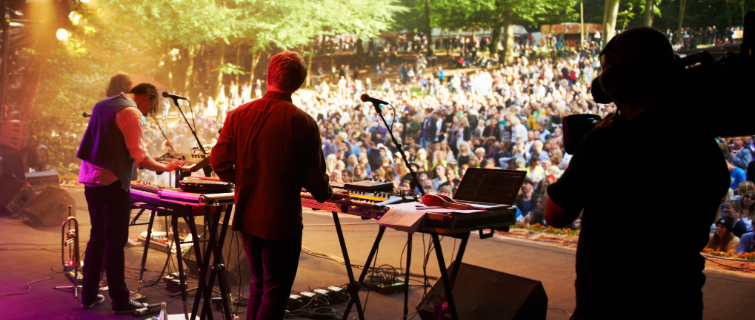
In more than a decade of performing at outdoor music festivals, American roots musician Jess Eliot Myhre had been rained out a few times, but she had never had an event canceled because of other extreme weather. And yet, in the horrendous summer of 2023, it happened twice: first on June 7, when wildfire smoke forced the cancelation of an outdoor concert in Bethesda, Md.; and again on Sept. 6, when extreme heat shuttered another open-air performance in Fairfax County, Va.
One can imagine the disappointment performers feel when something they had prepared for is suddenly called off. But Myhre, who is also an economic development consultant for Jon Stover & Associates, has more than a personal interest in climate change’s effects on outdoor events.
“It has a big impact on the arts community, and a sort of a ripple effect of enough performances and other events like this get canceled,” says Myhre, a recent graduate of the Master’s in Urban & Regional Planning program at Georgetown. “It really affects our public realm. It affects how people gather in our city. A lot of these events are really important to the identity, the vitality of our city, and cancelations are increasing. Some presenters are saying they don't even want to hold their events anymore because the risks are so high.”
A Way Forward
In her Capstone, “The Show Must Go On: Resilience Strategies for Outdoor Summer Music Events in the DMV,” Myhre looks at the current landscape of outdoor summer music concerts in the District of Columbia, Maryland, and Virginia—more than 260 events at more than 200 venues—and assesses, through current climate data and projections, how those events could be impacted in the next five to 25 years.

According to her analysis of data from the National Oceanic and Atmospheric Association (NOAA), there is now a 13 percent chance that “outdoor summer events will be canceled or significantly hampered by climate-induced extreme weather,” Myhre says. That rises to 20 percent in 2030 and 24 percent in 2050, mostly because of worsening extreme heat events.
Myhre proposes three responses to this threat, at least two of which are highly cost-effective. First, parks and recreation departments in the DMV would establish “Beat the Heat” lending libraries, which could include hydration stations, portable fans, “shade sails” to provide respite from the blazing sun, and misting areas, similar to the ones used at the National Zoo. She places the annual costs of pilot projects for these amenities at just $10,000 to $20,000 per jurisdiction.
Guidance and Education
Secondly, the District’s Homeland Security and Emergency Management Agency could provide the public and policymakers with more guidance and education on severe weather. And finally, there could be design solutions, whose costs would vary depending on the project. These could include creating better indoor-outdoor interfaces, doing better acoustic planning, and implanting nature-based solutions using trees, plants, and water sources.
During the pandemic, city dwellers got a glimpse of what urban areas might look and feel like if, for whatever reason, people choose to stay away. Since then, many cities have largely recovered, some spectacularly, others more incrementally. Extreme weather has the potential to hollow out those spaces again, creating what Myhre calls a “lonely public realm in the summer.”
But it doesn’t have to be this way, Myhre says, as long as community leaders squarely face the reality of climate change and take steps to prepare for the scorching summers to come.
“The summer of 2023, in many ways, was a shifting point in the arts world, when people realized that climate change’s impacts are hitting us now,” Myhre says. “It’s not the future. It’s not our kids. It’s not our grandchildren. These impacts are really hitting us now.”
